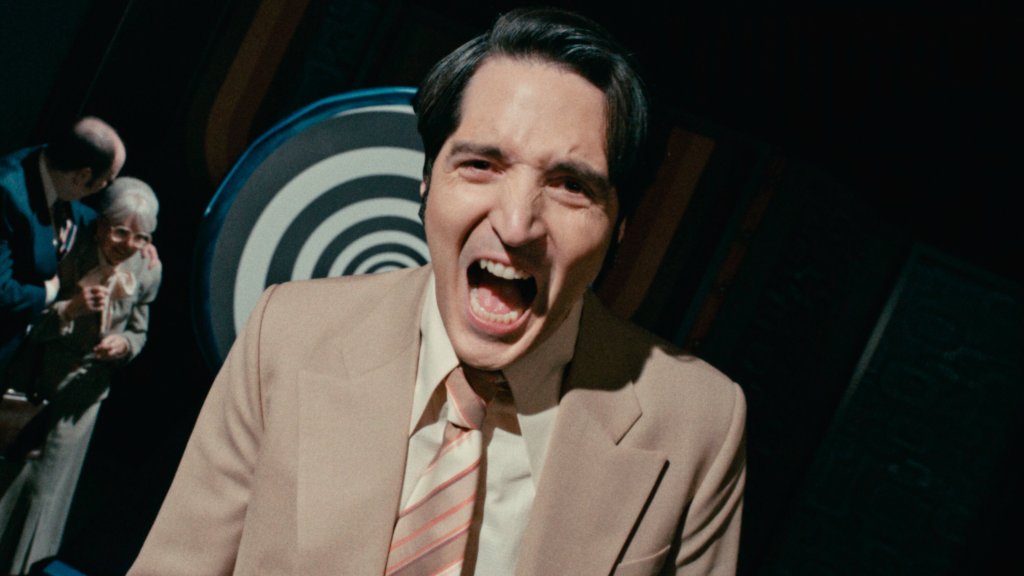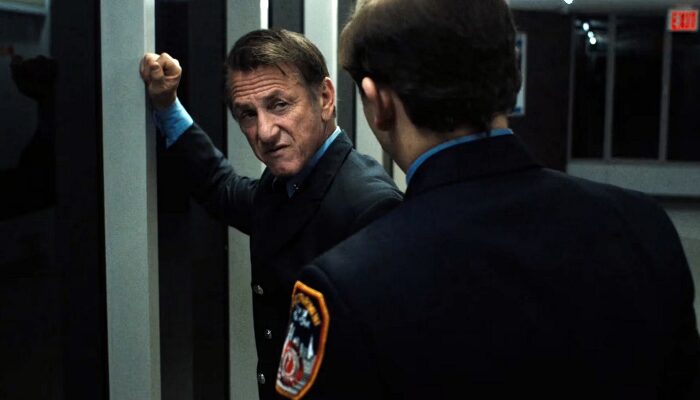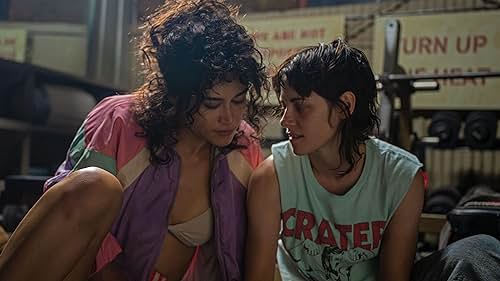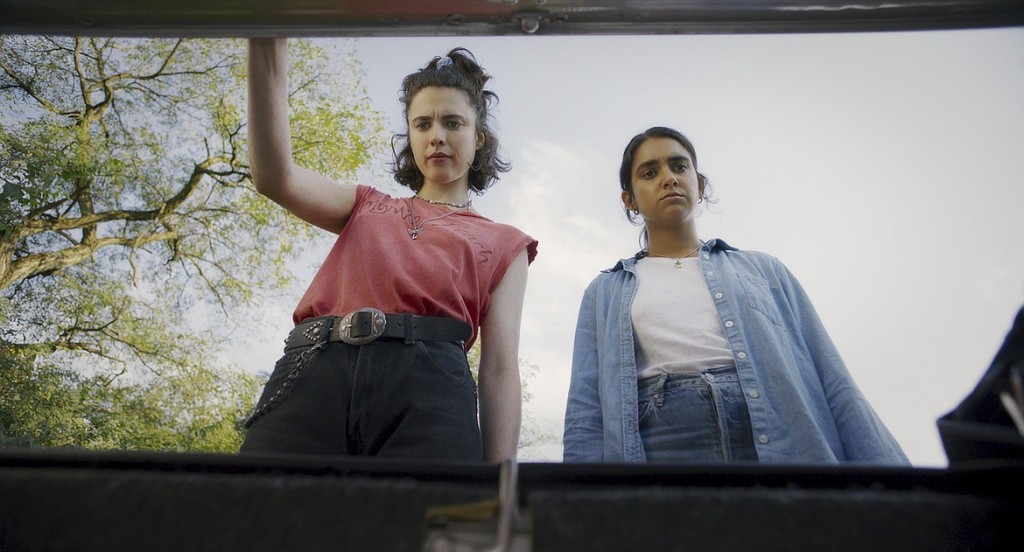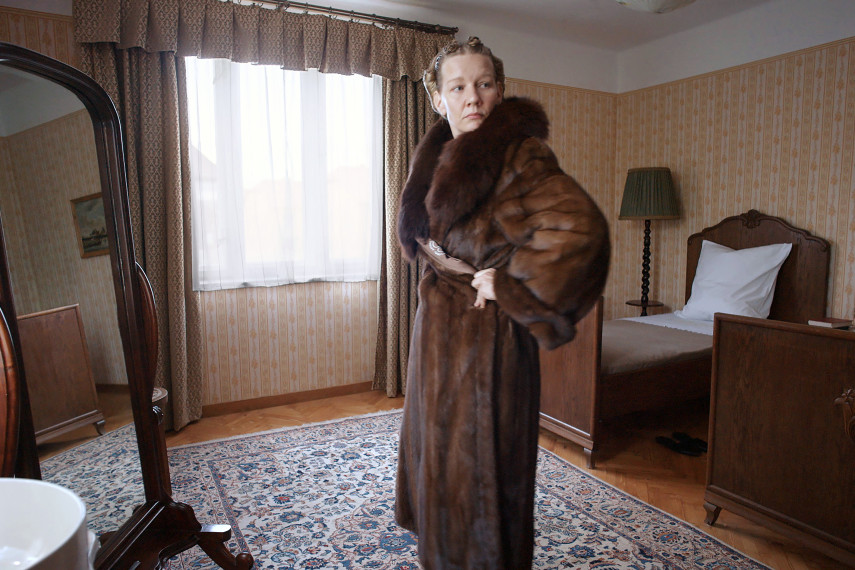For the longest time I kept giving Late Night with the Devil the benefit of the doubt, overlooking things and tones that didn’t square with the film’s presented milieu — it’s supposed to be footage from a late-night TV talk show that aired live on Halloween 1977. It’s got subtly powerhouse work by David Dastmalchian, striding into a rare lead role with confidence and his usual emotional transparency. He’s playing Jack Delroy, the host of the fourth-network show Night Owls with Jack Delroy, and it’s clear he’s watched enough vintage chat and horror-host shows to have internalized how such hosts acted and spoke. Dastmalchian makes the movie fun to watch all by himself. It’s the movie around him that falters.
Obsessed with beating Johnny Carson’s ratings, Jack loads his Halloween show with guests he hopes will lure and hook viewers. There’s “Christou” (Fayssal Bazzi), a psychic who purports to be in touch with audience members’ deceased loved ones. There’s Carmichael Haig (Ian Bliss), a Randi-type debunker of flim-flam. Finally, there’s reputedly possessed girl Lilly (Ingrid Torelli), whose parapsychologist guardian Dr. June Ross-Mitchell (Laura Gordon) saved her from some sort of demonic cult. It’s not long before Jack finds out the real target of satanic energy isn’t any of his guests.
Gee, could the (real-life) Bohemian Grove and its shadowy meetings of powerful men in the entertainment industry have something to do with it? Grasping at any means to take down Johnny, Jack has joined these weird ritualistic get-togethers in the woods. This isn’t a spoiler, as the too-explicit narration spills the beans right at the start. We then learn Jack’s wife had died of lung cancer despite never smoking (such a thing is rare but not so unheard-of as to suggest demonic cause). So we go into all the supernatural events with the knowledge that it’s all happening due to Jack; he is the nexus of this paranormal activity.
This is why horror movies get less legitimately frightening the deeper they wander into the weeds of exposition. It becomes Jack’s problem, Jack’s fault, rather than something random and scary that could happen to you. As I said, Late Night with the Devil is a fun tribute; sometimes it looks like genuine 1977 video footage and sometimes not (I assume because if it looked too much like video from 1977 it’d just look terrible, like a smeary, staticky fifth-gen dupe). It’s a decent enough stylistic calling card for the director brothers Colin and Cameron Cairnes, who also wrote and edited the film; perhaps next time they could hire another writer, or resist whatever pressure they may have been under to force the weird events — including levitation, projectile vomiting and someone with worms emerging from his flesh — to make some sort of narrative sense instead of allowing them to be harrowingly unexplained.
What’s worse, rather than letting the whole film just be the show’s footage, the brothers Cairnes often give us black-and-white “behind the scenes” segments that are necessary, I guess, to deliver plot points (as when someone dies offscreen and Jack hears about it during a commercial pause), but that also violate the imaginative contract we’ve bought into that this is actual coverage taped off of late-night TV. Not that we literally believe it’s real, of course, but we want to like what the movie is doing, want to make ourselves vulnerable to whatever scares it packs, and such breaks in the style and narrative shatter what should be unquestioning absorption. Again, it’s a writing issue.
Dastmalchian is one of the most effortlessly engaging actors we’ve got. In a recent two-parter on The Rookie he played a corrupt ex-soldier who faked his own death; his character showed such strong certainty that he was untouchable by the cops (including the one he once served with) we were left with little reason to doubt him. Late Night with the Devil lets Dastmalchian run the gamut from TV-host smarm to insecurity to grief to terror — it’s a full package. The movie would be considerably easier to dismiss and forget without him as Jack, the ringmaster of his own small circus whose animals get out of his control. For his pains, he’s just surrounded by a bunch of Australian actors who needed work. One of them, Rhys Auteri as Gus, Jack’s Ed McMahon figure, gives an on-target performance without ego. Most of the rest of the cast appear to be too “in character” as guests on a Halloween show — are they on the level or not? These directors seem to know how to leave good actors alone, but the (let’s say) other actors don’t get the guidance they need. By the time the climax fizzles out into a weak post-climax that fills the studio floor with casualties but leaves us unmoved, some of us may already have checked out mentally. Enjoy the movie for Dastmalchian, but don’t expect much more.
